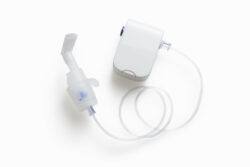Surgical Staplers and Staples
In the dynamic orchestra of the operating theatre, surgical staplers and staples play a vital role. These medical maestros facilitate swift, efficient wound closure, often replacing traditional sutures. This article peels back the sterilized curtain, exploring their evolution, types, risks, and the regulatory eyes of the FDA. We'll delve into the corporate giants manufacturing these tools, inspect the recalls shaking their reputation, and look ahead to the future of surgical stapler technology.

Key Takeaways
- Surgical staplers and staples are medical devices used in place of sutures to close wounds or incisions more quickly and with less pain for patients.
- They are often used in minimally invasive surgery and can be used to remove organs or reconnect parts of internal organs.
- Johnson & Johnson's Ethicon division and Medtronic are the two largest surgical stapler manufacturers, accounting for about 80% of the market in 2015.
- The FDA has expressed concerns about surgical stapler malfunctions, including misfires and incomplete staple formation, and has proposed reclassifying certain surgical staplers to address safety issues.
Understanding the Basics of Surgical Staplers and Staples
To understand the basics of surgical staplers and staples, it is essential to delve into their function as medical devices commonly employed in place of sutures for the closure of wounds or incisions. Surgical staplers have several advantages, including their ability to expedite surgical procedures, reduce post-operative complications, and ensure a more uniform closure than traditional sutures. They are particularly beneficial in minimally invasive surgeries, where they can be a crucial tool for surgeons. However, best practices for using surgical staples must be adhered to in order to minimize complications. These include ensuring the correct staple size is used for the tissue type and thickness, proper alignment of the stapler, and careful monitoring of the wound post-operation for signs of infection or dehiscence.
The Evolution of Surgical Staplers and Staples
From rudimentary tools of the past to today's advanced devices, the history of surgical staplers and staples has been marked by significant technological progress and, at the same time, ongoing challenges in ensuring patient safety. The advantages of surgical staplers have revolutionized many procedures. They offer speed, precision, and consistency, significantly reducing operative time compared to traditional sutures. This often translates into less post-operative pain and quicker recovery for patients. However, the evolution has not been without setbacks. Issues around device malfunction and associated complications have led to rigorous scrutiny and regulatory steps, emphasizing the importance of balancing technological advancements with safety. Despite these challenges, the adoption and continuous improvement of surgical staplers underpin their integral role in modern surgery.
Different Types of Surgical Staplers and Staples
While surgical staplers and staples are universally used in various surgical procedures, it is crucial to understand that there are actually different types of these devices, each designed for specific applications and surgical settings. The advantages of using surgical staplers include speed, precision, and the ability to access hard-to-reach areas. They come in a variety of forms, such as linear, circular, and skin staplers, each suited to particular surgical needs. Despite these advantages, common complications associated with surgical staples can occur, including infection, tissue damage, and staple misplacement or malfunction. Therefore, appropriate selection and careful usage of these devices are fundamental to minimize potential postoperative complications and maximize patient safety.
The Role of Surgical Staplers in Modern Medicine
In the realm of modern medicine, surgical staplers have emerged as pivotal tools for numerous procedures, and their application extends from closing simple skin wounds to complex organ surgeries. The advantages of using surgical staplers are numerous, including faster wound closure, decreased risk of infection, and lesser tissue trauma. This leads to quicker patient recovery when compared to traditional sutures. A comparison between surgical staplers and traditional sutures reveals that staplers offer a more uniform distribution of closure tension, which promotes healing. Staplers also minimize the risk of needlestick injuries for surgeons. Despite their higher initial cost, the overall efficacy and efficiency of surgical staplers make them an invaluable asset in the rapidly evolving field of medicine.
Potential Risks and Complications of Surgical Staplers
Despite their numerous medical applications and benefits, surgical staplers present certain risks and complications, with over 41,000 malfunction reports filed between 2011 and 2018, and these can range from minor postoperative infections to severe organ damage. When considering the use of surgical staplers, it is crucial to evaluate the risks vs benefits. The benefits include speed and efficiency in wound closure, while the risks encompass staple misplacement, stapler malfunction, and subsequent complications. Alternative options, such as traditional sutures or absorbable staples, may present fewer risks in certain scenarios, but may also lack the speed and simplicity of stapler use. Therefore, careful surgical planning, taking into account individual patient factors, is essential to mitigate the potential risks and complications of surgical staplers.
The Procedure of Applying Surgical Staples
Every surgical procedure involving the use of staples requires meticulous attention to detail, as even a single misplaced staple can lead to significant complications. The benefits and limitations of surgical staples are determined by the nature of the procedure and the skill of the surgeon. Benefits include speed of application, less tissue damage, and greater wound security. However, limitations include potential for infection, foreign body reaction and inadequate wound closure in tensioned areas. As for best practices for ensuring proper staple application, surgeons should ensure the staple gun is held perpendicular to the wound, apply even pressure, and verify the staple has fully closed before moving to the next. Adherence to these practices can mitigate complications and promote successful healing.
Case Studies: Instances of Surgical Stapler Use
Delving into the subject matter, let's examine specific patient's experiences with surgical staplers to further understand their practical application and potential complications. Case studies have documented various scenarios of surgical stapler use. Some highlight the benefits of surgical staplers in minimally invasive surgery, such as laparoscopic procedures, where their use has contributed to reduced surgery times and lower post-operative complications. On the other hand, there are also case studies on surgical stapler complications. These include instances where staple lines have leaked or the device has malfunctioned mid-procedure, leading to severe patient harm. Such real-life instances underscore the importance of careful device choice and handling, as well as the need for further training and regulation in this area.
Comparative Analysis: Surgical Staples Vs Sutures
While surgical staples have revolutionized wound closure in many surgical scenarios, it is crucial to compare and contrast them with traditional sutures to fully understand their respective benefits and drawbacks. In the comparison of effectiveness, surgical staples provide quicker, more uniform wound closure and are particularly effective in high-tension areas. However, they may have a higher risk of infection and tissue reaction compared to sutures. Sutures, on the other hand, offer more flexibility for wound approximation and are typically less expensive. The impact of surgical staplers on surgical outcomes is generally positive, reducing operation time and blood loss. Yet, their use requires careful patient selection and close postoperative monitoring to mitigate potential complications.
Major Manufacturers of Surgical Staplers and Staples
In the realm of medical device manufacturing, market dominance and innovative prowess are key characteristics of major manufacturers of surgical staplers and staples, such as Johnson & Johnson's Ethicon division, Medtronic, and 3M. These companies have consistently delivered high-quality devices that have revolutionized surgical procedures. However, safety concerns have emerged over time, leading to recalls and increased FDA scrutiny. For instance, Johnson & Johnson's Ethicon division had to recall a significant number of their devices due to malfunction concerns. Similarly, other major manufacturers have experienced recalls due to safety and performance issues. Despite these challenges, these companies continue to invest in technological advancements and rigorous quality control measures to ensure patient safety and improve surgical outcomes.
Recalls and Safety Concerns Around Surgical Staplers
The medical industry's increasing concern for patient safety has brought the issue of recalls and malfunctions of surgical staplers into sharp focus. These malfunctions can lead to serious risks and complications, including severe bleeding, infection, and permanent organ damage. Over the past decade, numerous recalls have been issued by major manufacturers due to these safety concerns. In response, regulatory actions have been taken by the Food and Drug Administration to heighten restrictions and oversight on these devices. The FDA has proposed reclassifying surgical staplers from low- to moderate-risk devices, and issued new guidance to physicians and hospitals. This is a critical step in addressing the safety concerns and reducing the potential risks associated with surgical staplers.
Regulatory Actions on Surgical Staplers by the FDA
Given the rising concerns over the safety of surgical staplers, the FDA has taken stringent regulatory actions to mitigate potential risks and ensure patient safety. Amid increasing reports of stapler malfunction incidents, the FDA has proposed reclassifying surgical staplers from low-risk to moderate-risk devices. This shift underscores the agency's commitment to bolstering patient safety through enhanced FDA regulations. The FDA has also consolidated two databases to make all reports of device malfunctions easily accessible to the public. These regulatory actions reflect the FDA's commitment to transparency and accountability in response to the tens of thousands of previously unreported cases of stapler malfunctions and associated injuries. The FDA continues to monitor the situation, emphasizing the importance of reporting any complications promptly.
Innovations and Technological Advancements in Surgical Staplers
Remarkably, the field of surgical staplers has witnessed numerous innovations and technological advancements, aimed at enhancing patient outcomes and improving surgical efficiency. These advancements in stapler design have led to the development of staplers that are more precise, user-friendly, and adaptable to various surgical procedures. For instance, the introduction of powered staplers has significantly reduced the manual force required during operations, thereby increasing the speed and accuracy of staple placement. Furthermore, improvements in staple line reinforcement technologies have minimized the risk of staple line leaks and bleeding. These innovations have had a profound impact on surgical outcomes, leading to shorter hospital stays, reduced postoperative complications, and ultimately, improved patient quality of life. The ongoing technological evolution in this field promises to revolutionize the future of surgical procedures.
Post-Operative Care for Wounds Closed With Surgical Staples
While surgical staples prove advantageous in terms of speed and efficiency during wound closure, it is crucial to follow specific post-operative care guidelines to ensure optimal healing and prevent potential complications. Essential aspects of post-operative wound care include regular cleaning of the wound area, monitoring for signs of infection, and ensuring the patient follows a nutritious diet to bolster healing. The staples should remain dry and clean to avert complications such as infection or wound dehiscence. In cases where complications occur, prompt management is necessary. This may involve antibiotic treatment for infections or possible removal of staples for severe complications. Patient education is also a crucial component in the post-operative care process, as it aids in early detection and reporting of any complications.
Patient Experiences and Testimonials With Surgical Staples
How do patients perceive the use of surgical staples, and what are their testimonies regarding their experiences with these devices? Patient experiences and testimonials reveal a high degree of patient satisfaction with the use of surgical staples. Many patients have reported that surgical staples expedite the wound healing process, reduce the time spent in the operating room, and minimize scarring. However, a small number of patients have expressed preferences for alternative closure methods, citing discomfort or anxiety associated with staple removal. Overall, while individual experiences may vary, surgical staples have emerged as a reliable method of wound closure that promotes patient satisfaction and efficient recovery. These patient testimonials serve as vital feedback for continuous improvement in surgical procedures.
Future Trends in Surgical Stapler Technology
Undeniably, the field of surgical stapler technology is advancing rapidly, and with these advancements come new trends that are set to redefine the future of surgical procedures. One such development is the emergence of smart stapler technology. These innovative devices are equipped with sensors to provide real-time feedback during surgery, reducing the risk of complications. They can monitor tissue thickness and adjust staple height accordingly, ensuring optimal staple formation. Another promising trend is the integration of robotic surgical staplers into minimally invasive procedures. These robotic systems offer superior precision and control, enabling surgeons to perform complex procedures with enhanced accuracy. As these technologies continue to evolve, they are expected to revolutionize the surgical stapler market, pushing the boundaries of what is possible in surgical procedures.
Frequently Asked Questions
How Should Patients Care for Their Wounds After Surgical Staples Have Been Applied?
Patients should diligently follow aftercare instructions post-staple application. Cleanliness is crucial in infection prevention; hence, keeping the wound clean and dry is vital. Regularly changing dressings as advised by the healthcare provider is essential. Avoid scratching or picking at the staples. Signs of infection such as redness, swelling, or pus should be promptly reported. Lastly, staple removal should be performed by a healthcare professional to avoid complications. Adhering to these steps ensures optimal wound healing.
Are There Any Alternatives to Surgical Staples for Wound Closure?
Yes, there are several alternatives to surgical staples for wound closure. These include traditional sutures, adhesive strips, and even medical-grade cyanoacrylate glues. Sutures are often preferred for their versatility and strength, while adhesive strips and glues can provide a less invasive option. These alternatives are particularly useful in cases where patients might have allergies to staple materials or when early staple removal is necessary. Each option has its own benefits and potential complications.
How Often Do Surgical Staplers Malfunction, and What Happens When They Do?
Stapler design flaws, akin to a faulty cog in a well-oiled machine, can lead to surgical stapler malfunctions. These occur more often than one may presume. When they do, the consequences can range from minor complications to severe injuries or even death. These malfunctions can result in bleeding, infection, and permanent organ damage. Manufacturer accountability is crucial in these situations, as it is their responsibility to ensure the safety and efficacy of their products.
Are There Any Specific Medical Conditions or Scenarios Where the Use of Surgical Staples Is Not Recommended?
Certain medical conditions or scenarios may not recommend the use of surgical staples. Staple allergies, particularly to certain metals used in staples, can cause complications, including skin irritation or systemic reactions. Additionally, infection risks are heightened in areas of poor blood supply or contaminated wounds. Therefore, patient history, wound location, and operative environment must be thoroughly evaluated before deciding on the use of surgical staples.
What Is the Process for Recalling Surgical Staplers and How Are Patients Notified in the Event of a Recall?
Recall procedures for medical devices typically involve the manufacturer notifying the FDA of the issue, followed by a public announcement. Affected healthcare providers are usually informed directly, who then notify patients using the device. Patient communication may include letters, emails, or phone calls, explaining the reason for the recall and the necessary actions. The specific process may vary depending on the severity of the situation and the number of patients affected.
Conclusion
In conclusion, surgical staplers and staples, the silent heroes of the operating room, have revolutionized the medical field. However, like a double-edged sword, they carry potential risks alongside their benefits. Vigilance by manufacturers and the FDA, alongside technological advancements, is crucial in mitigating these risks. The journey of these medical marvels, from their rudimentary beginnings to future trends, underscores their indispensable role in modern medicine, and the ceaseless quest for safer, more effective surgical tools.

This post has been generated by AI and was not reviewed by editors. This is Not legal advice. Please consult with an attorney.




